


|
 |
|
|
#26 |
|
Registered Member
Join Date: Feb 2001
Location: Long Island, NY
Posts: 246
|
Steve,
Nice to have you on Reef Central ! 
|
|
|

|
|
|
#27 |
|
Registered Member
Join Date: Oct 1999
Location: San Francisco, CA, US
Posts: 346
|
Hey they changed my reply. Free Speach my @$$.
Kids don't read this. Where's my right to creative cursing... Lets continue this mess. Part two of the reply to Steve's reply: Again the question remains, what is more effective a settling out in a dsb, where nitrate (N), P, S, C, and many other substances are cycled and food is recycled into plankton to feed the system, or the filtering aspects of sponges? I would say both are important, but the DSB seems easier and more beneficial IMO. Both can be combined to some extent in a low flow refugium. Just elevate the cryps a deal above the sandbed so they don't get clogged and use a high tank. That IMO would be the way to go. Or better yet having a separate tray to have water enter at before overflowing into the settling chamber. This would ensure that the sponges remain in the water at all times and do not automatically consume a good deal of the plankton from the sandbed. I don't know if there are practical problems apart from ensuring no air enters, which is easy enough to fix. The question that remains is where do you get good non toxic cryps. Might have some potential as a hang on filter. Something you can sell as a organic mechanical filter. I do like the feeding aspect of sponges, especially keeping angels or butterflys. The questions that remain are how do you house a system that replicates an ecosystem. The amount of "supporting zones" would likely be three to five fold larger than the main tank. Well more like 600 fold, but lets remain semi practical. If people can come up with idiot proof products and methods to accomplish this in small areas I think that would be the practical contribution to the hobby. Box o' Cryps sounds interesting. I'm still of the opinion that dsb are more beneficial and a higher priority but soon after I would add algae and then sponges. I still like having a airstone driven CC skimmer in the system replicating the big open sea etc. Flowing at about 1/3 tank turnover. Air to water ratio of 3-5 to 1 air:water. And a contact time of about 1min. Little yellowing, high plankton survival, lowest electricity, lowest toxins,etc. >Heinrich wrote Most systems are still starved and that's seen on the success few people have with non photosynthetic corals long term. ST: They are not starved. They are using protein skimmers and sediment beds to hide the POM, collect the partially processed food and remove the collodials. Starved of live plankton, such as phytoplankton, etc. The POM and DOM are waste, which corals can utilize a bit but as everything the dosage determines the poison. If your system isn't balanced then the POM can become a problem. But again this is mostly true for SPS, LPS on the other hand require a whole lot more DOCrud... I never had luck with ellegances, or goniporas until they were in the crud collecting areas of the tank. Again its zonation. Maybe you should have two different returns one from a refugium going to the LPS and another from a cryps filter going to the SPS if you're planning on keeping both together. That should solve some problems nicely and I believe would work out well. With a gravity flow refugium there is also no danger of water siphoning back so the outlet of the refugium can be directed to the tank bottom for the benefit of the LPS. The return from the non lit cryps filter in the sump can then go to the Sps that want high lots of light on the top of the tank. Nice solution. I'm starting to see some better usages. >Heinrich wrote Again sponges produce comparatively little plankton and consume a good deal of bacteria. Which might be helpful for coral diseases, who knows. ST: Sponges replace the skimmer. We don't want them adding food back into the system. Just like we don't want the Berliner adding skimmer effluent back into his reef. Unless of course we add marine angelfish and other sponge predators to cycle the sponges. Instead of harvesting them. There is plenty of food already in your reef. The problem has been in making it presentable and collectable to the suspension feeders. I ran fully populated cryptic, semi-cryptic and semi-exposed zones in tanks that were never fed. They derived all their food from the exposed zone. Its documented in the book.> I'm not sure if I understand the analogy with pouring effluent back into the reef and organisms cycling waste into plankton. The skimmer would collect waste over a period of time, concentrating it and usually it decomposes in the collection cup. Adding this would certainly not be very good. Taking your analogy, of the berliner, and using the waste out of the skimmer to grow some phytoplankton, raise some copepods, rotifers, mysis, etc, and turn them into nutritional food and then add that food back to the system would be the analogy of having organisms that cycle waste. Again some of the effluent would turn into growth and might have to be harvested. Similar in the analogy some effluent will get onto the floor and needs to be cleaned up before the wife gets back so only a portion is brought back into the tank. I for one am lazy and like my zones to do all that for me. That the cryptic zones can get the majority of their food from the exposed zones is understandable. But looking at nature we see that our tanks produce nowhere close to the amount of plankton that the other areas produce. So with relying on just cryps we have a one sided off ballance. Mainly a lacking of diversity and a full cycle of producing, recycling and consuming. I don't think you would notice the negative effects of the lack of food for a couple of years. Probably mostly in the ability of corals to fight of disease, and recover tissue. I'm amazed at how organisms can survive even in worst of situations. But keeping a kid alive for a year or 6 months isn't an acomlishment as much as until old age sets in. Malnurishment would be an interesting task over say the next couple of hundred years, to study if there's still corals left in the next 30yrs. My sense of keeping a zen like balanced ecosystem is not happy by shifting the balance soley onto the consuming side. This reminds me of running, microns, clay, skimmers, ozone, UV, denitrators, carbon, resins, etc, just to try to keep the parameters where you want them, mostly by eliminating POM and DOM. But at the same time removing plankton. The use of cryps can start to look as if were trying to get organic lean systems. Not what I like and I know that's not what you want either. Yet I fear that this is where things are possibly headed. The counterswing to refugia, maybe? Each system needs to have all the necessary components and cryps are definitely a viable alternative as some components in a closed ecosystem. God damn this is getting long again, alright lets finsh things fast. >Heinrich wrote >But if you can't see them the appeal is low unfortunately. ST: You can see em. Your pupils will adapt, but you can alsways light em up with a flashlight or an incandescnet.> Get some sources of nice looking sponges and seasquirts and I agree the appeal would be higher than most of the stuff surviving off of the LR. Strange thing is that some of the nicest seasquirts survive only in high flow high plankton water. So again getting the zonations right will be the tricky part where the experts are needed. Little kits would be a good idea. Unless your a PhD in Zoology specializing in Marine Inverts, well maybe just a MA. If someone were to offer hardy beautiful sponges and squirts in an easy use unit, replacing a skimmer but still having refugia, that would certainly be a contribution to the hobby. A no electricity skimmer and Mechanical filter that needs cleaning every couple of months doesn't sound bad. Alright hope to hear from you soon Steve. 93! Heinrich
__________________
93! Heinrich |
|
|

|
|
|
#28 |
|
Premium Member
 Join Date: Jul 2001
Location: Planet Earth
Posts: 171
|
>Heinrich wrote
>Again, I know little about this. But when a hobbyist seeds his system he has no way of >ensuring that he gets "cryptic sponges" so he is likely to seed his system with normal >sponges, which use and release highly effective toxins. Exposed sponges tend to be very distinctive. Its relatively easy to tell the difference. Unfortunately, most of the sponges that have been historically offered for sale in the hobby are from exposed zones. These sponges do not survive well in cryptic habitats. In general, if a sponge grows out of a rock that is held in a cryptic zone, chances are real good it is a cryptic sponge. Exposed sponges need strong current flows and some need light. Also, sponges growing under corals tend to be semi-cryptic. >Heinrich wrote >Gelb=Yellow Stoffe=Substances causeing the before word. Fine. I just find it odd to see articles written in english that use a german word, when an original definition for the term in english is documented in the scientific literature. >Heinrich wrote >That's where deep sand beds come in handy since they are the one's who break down the >humins (def=humic substance). Actually, its not the sand that does it, its the bacteria that break down the humins. You are just providing a place where the bacteria can proliferate in high densities. Thats always the trade off. High bacterial densities in close proximaty to delicate coral animals. I think a deep sand bed refugium that would never suffer major disturbances might be a solution to the humic problem, but I am not too concerned about it. Shallow sand beds can actually contribute to the humic compounds if they are illuminated. Some have been found to be autotrophic in nature (lagoon sand beds). The question is how deep must the bed be to become heterotrophic ? >Heinrich wrote >I very much agree with the zonation just not necessarily on the priority of one >over the other. They are equally important. Concerning water changes, there are lots of methods to utlize but my rule of thunb is to never expose any animals during the water change. Otherwise you are going to stimulate coral slime release and stress. This will counter the benifits of changing water. This means you only pull out as much as you can without exposure. Then replace. Then remove. Then replace. So on and so on until you have changed the amount you want. Its less efficient then doing it all at once but it is much less stressful to your animals. My main way to do tanks is self- contained. There are no sumps and no plumbing. I dont place sponges in the upper couple of inches of water. >Heinrich wrote >Not arguing with that just added bioload and they do produce their own waste, >which nobody can deny. Compared with the efficiency of bacteria, or even with algae >which don't really compare to bacteria, their pros and cons especially virtually >exclusively relying on them to deal with waste is debatable I think. The EG systems, like all modern day systems, utilize live rock for bacterial based filtration. There are however some sponges, called Bacteriosponges, that could be an 'All in One' filter, and I do talk about their potential in my Sponge book. >Heinrich wrote >The question is how do we give the organisms the best environment for the least dollars, effort and space and make it look nice? A self-contained zoned EG system does really well with the first three, but making it look 'nice' has been the trick. But then again, 'beauty is in the eye of the beholder'. >Heinrich wrote >The food input to the system will be recycled again and again without the >negative effects of poluting the system. The main issue is handling the unprocessed organics that were 'created' in the exposed zone. This creation process (photosynthesis) is constantly adding organic compounds into the system that need to be completely and efficiently processed. >Heinrich >Also a lot of corals really like the POM. See Sprung's selling "Snow" something. >I periodically stirr up the sand to get that effect. Again it all comes down to >ballancing the system. In my EG systems that are without sediments, I dont have to stir the sediments to get snow. It is always there. Occasional stirring of unprocessed matter does get more POM to the suspension feeders though. |
|
|

|
|
|
#29 |
|
Registered Member
Join Date: Sep 2003
Location: Huntsville AL
Posts: 1,814
|
Has anybody tried this method? If so any feedback please....
|
|
|

|
|
|
#30 |
|
Registered Member
Join Date: Sep 2003
Location: Huntsville AL
Posts: 1,814
|
^^^^
|
|
|

|
|
|
#31 |
|
Registered Member
Join Date: Nov 2003
Location: Ontario, Canada
Posts: 554
|
It would be interesting to see this theory in action... this is a pretty old thread though, so who knows what other research has come out since then.
Tim
__________________
"I bet a funny thing about driving a car off a cliff is; while you're in midair you still hit those brakes... Hey, better try the emergency brake! - J.H." Current Tank Info: None currently |
|
|

|
|
|
#32 | |
|
Registered Member
Join Date: Sep 2003
Location: Huntsville AL
Posts: 1,814
|
Quote:
|
|
|
|

|
|
|
#33 |
|
Registered Member
Join Date: Aug 2007
Posts: 1,966
|
....... good reading bump for an old thread!
anyone running a cryptic fuge and have results/recoms to share? regards |
|
|

|
|
|
#34 |
|
Premium Member
 Join Date: Oct 2007
Location: Cary, NC
Posts: 3,760
|
alot of great discussion going on here.
just wanted to aska quick question in regards to what size particular matter sponges grab. I have a 220g reef with a 50g refugium. my 220 reef has the 5" DSB, while the 50g fuge is barebottom with lots of rubble and live rock (backwards I know  ). ).Anyways, I have not been running any lights on my fuge yet (though I plan to, possibly). I am seeing very rapid sponge growth in both tanks, the sponges range from 1/8" up to 1.5", and theyre all white cylindrical shapes. What's strange though is that every sponge I see is literally STUFFED full of detritus/pariticulate matter, but they seem to be growing. I had thought sponges didn't really filter large particulate matter, but it appears mine are having no problem with this. Would you say that its unhealthy for sponges to get stuffed with larger particulate matter? Can they digest it over time? Thanks, Ryan
__________________
- Ryan B "that is enough skimmate to ruin lives." - GSMguy Current Tank Info: 220g Display, 70g sump, 35g frag, 50g fuge, 2x250w MH, 1x400w MH, 2x80w T5, 2x140w VHO Actinic |
|
|

|
|
|
#35 |
|
Registered Member
Join Date: Jun 2008
Posts: 331
|
I read a post from a guy who helped his friend create a "cryptic zone" through covered rubbermaid containter with live rock inside, with pipes bringing water in and out.
He said that after a year, they had to break it down because eventually it became so stuffed with sponges and other life that water would not go in anymore. When they opened it he said that there was a huge amount of critters crawling around there so that it was disgusting to look at. That sounds like a very simple and effective cryptic zone to set up, and also an excellent means of nutrient export, as long as you have a good system of harvesting the biomass from the system. From his description of the amount of tiny critters in there (it wasn't a very detailed description) it sounds like it might function as a refugium as well, if any of the critters made it out to the DT. Any thoughts? |
|
|

|
|
|
#36 |
|
Registered Member
Join Date: Aug 2007
Posts: 1,966
|
...
|
|
|

|
|
|
#37 |
|
Moving Money
 Join Date: May 2001
Location: Rockaway, NJ
Posts: 1,764
|
Who's Dr. Ron? ;-)
__________________
Jim Roth --------------- Current Tank Info: 250G custom SPS System w/3X Radions |
|
|

|
|
|
#38 |
|
Registered Member
Join Date: Aug 2007
Posts: 1,966
|
|
|
|

|
|
|
#39 |
|
Registered Member
Join Date: Dec 2002
Location: Bay Area CA
Posts: 1,940
|
Although I did not read Steve's work, I heard the story of how Steve was inspired to research cryptic zones and recalled his pile o' rubble sump back in 95 when I used to visit. (Steve that was a complement so don't blow me up
 ) Steve definitely had something going on in that tank that others could not seem to achieve. For whatever reason, I have always associated a good portion of that tank's success to that sump full of rock. ) Steve definitely had something going on in that tank that others could not seem to achieve. For whatever reason, I have always associated a good portion of that tank's success to that sump full of rock. I am in the process of setting up a new tank and I wanted to incorporate a cryptic component to my sump. Reading this thread, I think I got most of the idea with the exception of the low flow part. I believe, however, that there will still be areas in the rubble pile that will not receive much flow. Hopefully it will be enough to achieve the goal. I invite Steve and others to comment. The design is rather simple. I created a tower that will be filled with Tonga rubble. The walls of the fuge are smoked acrylic and the lid and back wall of the fuge are black acrylic to block out light. There are two perforated trays inside the fuge. The first one rests about 3" off the bottom. The second is 3" from the top and rests above the rubble pile. The tank overflow drain pipe runs through the rubble pile and lets out under the pile in the 3" gap between the bottom and first tray. Water must flow up through the pile in order to exit out the drain at the top of the tower. Hopefully there will not be so much bubbles and turbidity that it will inhibit cryptic sponge growth. Some images: 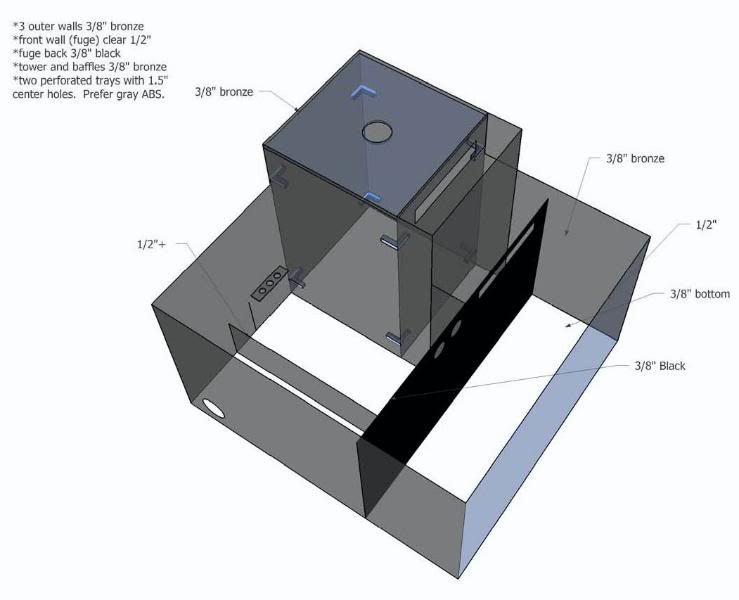 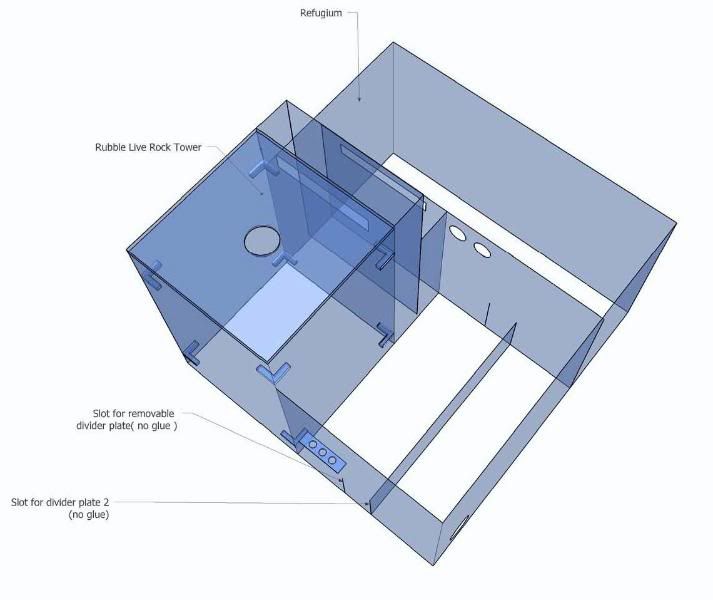 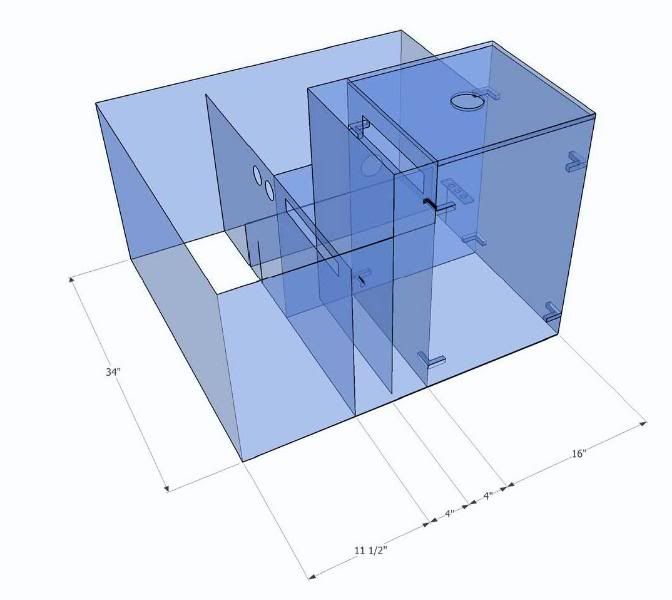 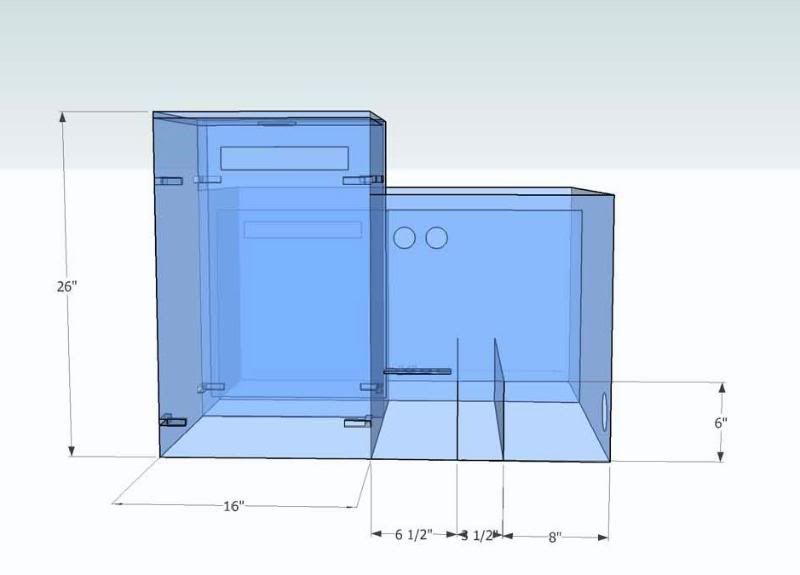 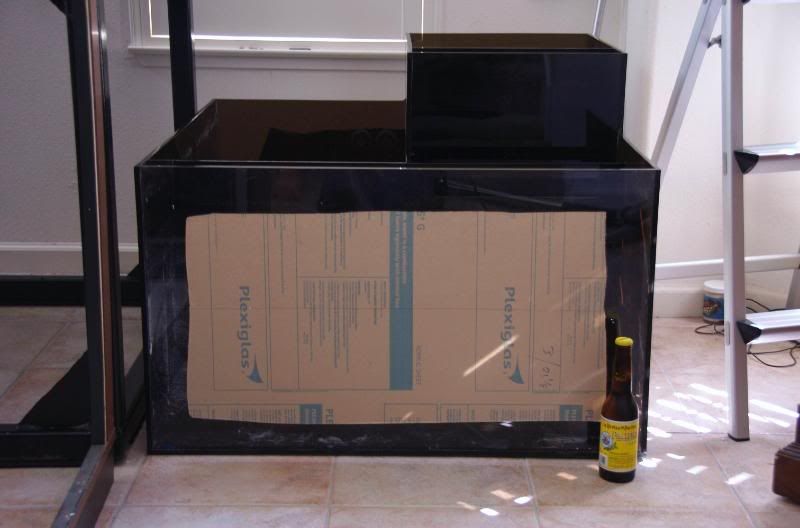  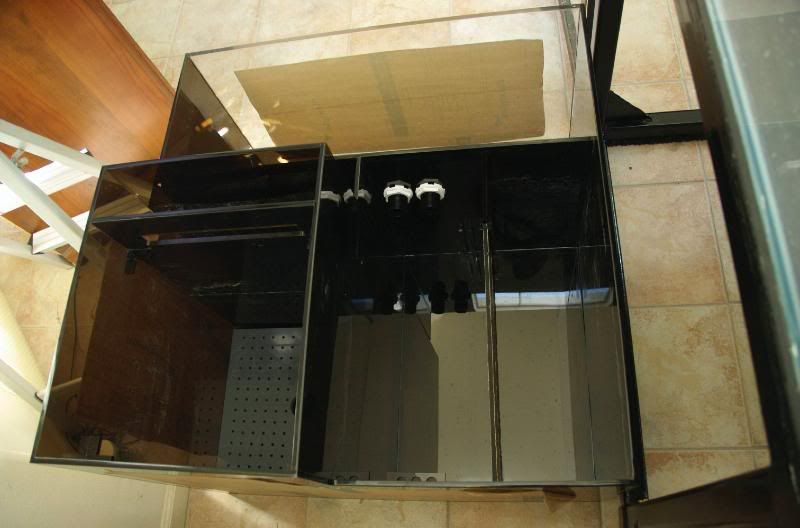  
|
|
|

|
|
|
#40 |
|
Registered Member
Join Date: Aug 2007
Posts: 1,966
|
AgentSPS
if you are waiting for a reply from steve tyree well you might be waiting for awhile... see below for when his last posting was made to this thread... 07/12/2001 10:37 PM Steve Tyree Premium Member Registered: Jul 2001 Location: Planet Earth Occupation: Author, Publisher, Web Site Manager, Reef Farmer, Coral Reef Importer, Coral Reef Distributor, Lecturer Posts: 133 i bumped this thread bec of the good info in it and hoped to get some good dialogue going! your sump/design looks well thought out where did you get the idea for making it that way?... very interesting design! regards |
|
|

|
|
|
#41 |
|
Registered Member
Join Date: Jun 2008
Location: Lakeland, TN
Posts: 430
|
Tagging along, I tried this with a Fluval 404 with all media removed and the flow dialed back. Within a few weeks all the baskets and the filter pad trays were covered in tube worms and sponges. It was pretty neat, but then the Fluval died.
__________________
Libertas, numquam ex more! Current Tank Info: 110g display, 30g sump, 20g refugium, 2x400w XM 20k halides, 4x96w pc, 1x 23w CF, 1 T5, 2x tunze 6025, 2x tunze 6045, 1x Genx pcx-40, Big fat Octopus Skimmer w/ Sicce pump and bubble plate, 2x PhosBan Reactor |
|
|

|
|
|
#42 |
|
Registered Member
 Join Date: Oct 1999
Location: Sarasota, Florida
Posts: 30,279
|
I read the book and set up a cryptic refugium in 2001 but shortly later we moved and I haven't tried again.
There was one thing about Tyrees setups that struck me as different from the average hobbyist. His tanks were holding tanks for commercial coral distribution. As a result new organisms were introduced on a regular basis and diversity was always being replenished. In established reef systems diversity is always being reduced as stronger organisms survive and weaker organisms perish. I still think the concept has merit but I would like to hear about experiences with the more static environment of the typical reef tank.
__________________
Less technology , more biology . Current Tank Info: 30 gallon half cube and 5.5, both reef tanks |
|
|

|
|
|
#43 | |
|
Registered Member
Join Date: Dec 2002
Location: Bay Area CA
Posts: 1,940
|
Quote:
Haha oops failed to notice that. I did think it was odd to see Steve 'back' on RC. As for the sump design, I did put a lot of hours into the design. It is, however, essentially the same idea as a wet dry sump from a design perspective. Only difference is that the tower has no 'dry' part as its filled with water. |
|
|
|

|
|
|
#44 |
|
Moved On
Join Date: May 2009
Location: Phoenix Arizona
Posts: 607
|
ttt
|
|
|

|
|
|
#45 | |
|
Registered Member
Join Date: Jun 2009
Posts: 1
|
Quote:
 . .
|
|
|
|

|
|
|
#46 |
|
Registered Member
Join Date: May 2004
Location: Dallas, TX
Posts: 11,033
|
Anyone have updates ?
__________________
Failure isn't an option It's a requirement. 660g 380inwall+280smp/surge S/L/Soft/Maxima/RBTA/Clown/Chromis/Anthias/Tang/Mandarin/Jawfish/Goby/Wrasse/D'back. DIY 12' Skimmer ActuatedSurge ConcreteScape |
|
|

|
|
|
#47 |
|
Registered Member
Join Date: Jun 2008
Location: Tampa Fl
Posts: 87
|
I'd be interested if this thread started up again. I've had an cryptic fuge for a while now and wouldn't mind hearing other experiences.
|
|
|

|
|
|
#48 | |
|
Registered Member
Join Date: Dec 2009
Location: Wichita KS
Posts: 2,621
|
Quote:
I also remember several here at RC that run rock in Brute containers that may have some cryptic characteristics.
__________________
John, Current Tank Info: In-process, 90 Gallon SPS Reef |
|
|
|

|
|
|
#49 |
|
Premium Member
 Join Date: Jul 2001
Location: Planet Earth
Posts: 171
|
Wow. Some how Reef Central tagged me about this old thread. No reason to rehash this old info. Science has progressed quite a bit since then. We now know the Sponge nutrient cycle is very important to tropical reef platforms. If you don't have cryptic sponges, you are not reefing. Lol. Hard to keep em out anyways.
|
|
|

|
|
|
#50 |
|
Registered Member
Join Date: May 2004
Location: Dallas, TX
Posts: 11,033
|
Welcome back Steve!
What would you recommend as a more current resource for the Sponge nutrient cycle?
__________________
Failure isn't an option It's a requirement. 660g 380inwall+280smp/surge S/L/Soft/Maxima/RBTA/Clown/Chromis/Anthias/Tang/Mandarin/Jawfish/Goby/Wrasse/D'back. DIY 12' Skimmer ActuatedSurge ConcreteScape |
|
|

|
 |
| Thread Tools | |
|
|